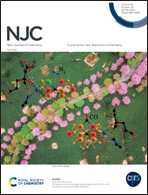Si doped T-graphene: a 2D lattice as an anode electrode in Na ion secondary batteries†
Abstract
Heteroatom doping into 2-dimensional lattices of materials such as graphene brings revolutionary reform in the field of materials endowing the parent material with remarkable properties. Herein, a state-of-the-art 2-dimensional carbon lattice doped by Si atoms, Si doped T-graphene (t-SiC3), has been reported and its application as an anode electrode material in secondary Na ion batteries has been demonstrated. A detailed theoretical investigation following density functional theory establishes the geometric, physical, and chemical domains of the monolayer. The metallic nature of the monolayer verified by the density of states adds up to its advantage of being used as the electrode. Moreover, efficient adsorption in addition to easy diffusion emphasizes the high rate kinetics of the monolayer. Efficient charge redistribution is achieved signifying energetically stable adsorption of Na ions during the electrochemical half cell cycle. For practical realization, an efficient storage capacity of 686 mA h g−1 along with a lower energy barrier of 0.3 eV for Na ion diffusion is obtained. Further, the average voltage of 0.2 V calculated for t-SiC3 renders its efficacy to be used as an anode material in reversible Na ion batteries. The properties underlying t-SiC3 extend its potential for a wide spectrum of applications.



 Please wait while we load your content...
Please wait while we load your content...